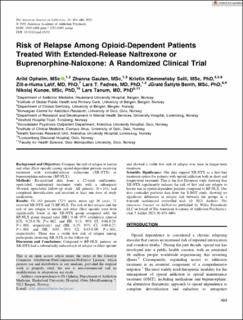| dc.contributor.author | Opheim, Arild | |
| dc.contributor.author | Gaulen, Zhanna | |
| dc.contributor.author | Solli, Kristin Klemmetsby | |
| dc.contributor.author | Latif, Zill-E-Huma | |
| dc.contributor.author | Fadnes, Lars T. | |
| dc.contributor.author | Saltyte Benth, Jurate | |
| dc.contributor.author | Kunøe, Nikolaj | |
| dc.contributor.author | Tanum, Lars Håkon Reiestad | |
| dc.date.accessioned | 2021-09-21T05:43:05Z | |
| dc.date.available | 2021-09-21T05:43:05Z | |
| dc.date.created | 2021-09-14T13:05:52Z | |
| dc.date.issued | 2021 | |
| dc.identifier.issn | 1055-0496 | |
| dc.identifier.uri | https://hdl.handle.net/11250/2779686 | |
| dc.description.abstract | Background and Objectives: Compare the risk of relapse to heroin and other illicit opioids among opioid-dependent patients receiving treatment with extended-release naltrexone (XR-NTX) or buprenorphine-naloxone (BP-NLX).
Methods: Re-analyzed data from a 12-week multicenter, open-label, randomized treatment study with a subsequent 36-week open-label follow-up study. All patients, N = 143, had completed detoxification and received at least one dose of study medication.
Results: Of 143 patients (72% men), mean age 36 years, 71 received XR-NTX and 72 BP-NLX. The risk of first relapse and the risk of any relapse to heroin and other illicit opioids were both significantly lower in the XR-NTX group compared with the BP-NLX group (hazard ratio [HR], 0.46; 95% confidence interval [CI], 0.28-0.76; P = .002, and HR, 0.11; 95% CI, 0.04-0.29; P < .001, respectively) and (HR, 0.15; 95% CI, 0.09-0.27; P < .001 and HR, 0.05; 95% CI, 0.03-0.09; P < .001, respectively). There was a stable low risk of relapse among participants receiving XR-NTX in the follow-up.
Discussion and Conclusions: Compared to BP-NLX, patients on XR-NTX had a substantially reduced risk of relapse to illicit opioids and showed a stable low risk of relapse over time in longer-term treatment.
Scientific Significance: Our data support XR-NTX as a first-line treatment option for patients with opioid addiction both in short and longer-term treatment. This is the first European study showing that XR-NTX significantly reduces the risk of first and any relapse to heroin use in opioid-dependent patients compared to BP-NLX. Our data contradict previous data from the X:BOT study, showing no significant difference in relapse risk between the groups in a 6-month randomised controlled trial. | en_US |
| dc.language.iso | eng | en_US |
| dc.publisher | Wiley | en_US |
| dc.rights | Attribution-NonCommercial-NoDerivatives 4.0 Internasjonal | * |
| dc.rights.uri | http://creativecommons.org/licenses/by-nc-nd/4.0/deed.no | * |
| dc.title | Risk of Relapse Among Opioid‐Dependent Patients Treated With Extended‐Release Naltrexone or Buprenorphine‐Naloxone: A Randomized Clinical Trial | en_US |
| dc.type | Journal article | en_US |
| dc.type | Peer reviewed | en_US |
| dc.description.version | publishedVersion | en_US |
| dc.rights.holder | Copyright 2021 American Academy of Addiction Psychiatry | en_US |
| cristin.ispublished | true | |
| cristin.fulltext | original | |
| cristin.qualitycode | 1 | |
| dc.identifier.doi | 10.1111/ajad.13151?af=R | |
| dc.identifier.cristin | 1934145 | |
| dc.source.journal | American Journal on Addictions | en_US |
| dc.source.pagenumber | 453-460 | en_US |
| dc.identifier.citation | American Journal on Addictions. 2021, 30 (5), 453-460. | en_US |
| dc.source.volume | 30 | en_US |
| dc.source.issue | 5 | en_US |

